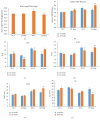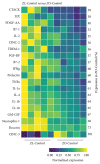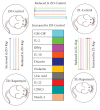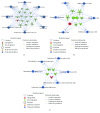Differential Regulation of Cardiac Function and Intracardiac Cytokines by Rapamycin in Healthy and Diabetic Rats
- PMID: 28408970
- PMCID: PMC5376943
- DOI: 10.1155/2017/5724046
Differential Regulation of Cardiac Function and Intracardiac Cytokines by Rapamycin in Healthy and Diabetic Rats
Abstract
Diabetes is comorbid with cardiovascular disease and impaired immunity. Rapamycin improves cardiac functions and extends lifespan by inhibiting the mechanistic target of rapamycin complex 1 (mTORC1). However, in diabetic murine models, Rapamycin elevates hyperglycemia and reduces longevity. Since Rapamycin is an immunosuppressant, we examined whether Rapamycin (750 μg/kg/day) modulates intracardiac cytokines, which affect the cardiac immune response, and cardiac function in male lean (ZL) and diabetic obese Zucker (ZO) rats. Rapamycin suppressed levels of fasting triglycerides, insulin, and uric acid in ZO but increased glucose. Although Rapamycin improved multiple diastolic parameters (E/E', E'/A', E/Vp) initially, these improvements were reversed or absent in ZO at the end of treatment, despite suppression of cardiac fibrosis and phosphoSer473Akt. Intracardiac cytokine protein profiling and Ingenuity® Pathway Analysis indicated suppression of intracardiac immune defense in ZO, in response to Rapamycin treatment in both ZO and ZL. Rapamycin increased fibrosis in ZL without increasing phosphoSer473Akt and differentially modulated anti-fibrotic IL-10, IFNγ, and GM-CSF in ZL and ZO. Therefore, fundamental difference in intracardiac host defense between diabetic ZO and healthy ZL, combined with differential regulation of intracardiac cytokines by Rapamycin in ZO and ZL hearts, underlies differential cardiac outcomes of Rapamycin treatment in health and diabetes.
Figures









Similar articles
-
Comparison of Cardiac miRNA Transcriptomes Induced by Diabetes and Rapamycin Treatment and Identification of a Rapamycin-Associated Cardiac MicroRNA Signature.Oxid Med Cell Longev. 2018 Dec 17;2018:8364608. doi: 10.1155/2018/8364608. eCollection 2018. Oxid Med Cell Longev. 2018. PMID: 30647817 Free PMC article.
-
Renal activity of Akt kinase in obese Zucker rats.Exp Biol Med (Maywood). 2008 Oct;233(10):1231-41. doi: 10.3181/0801-RM-29. Epub 2008 Jul 18. Exp Biol Med (Maywood). 2008. PMID: 18641049
-
mTORC1 inhibitors rapamycin and metformin affect cardiovascular markers differentially in ZDF rats.Can J Physiol Pharmacol. 2017 Mar;95(3):281-287. doi: 10.1139/cjpp-2016-0567. Epub 2017 Jan 4. Can J Physiol Pharmacol. 2017. PMID: 28177677 Free PMC article.
-
Adaptive mechanisms to compensate for overnutrition-induced cardiovascular abnormalities.Am J Physiol Regul Integr Comp Physiol. 2011 Oct;301(4):R885-95. doi: 10.1152/ajpregu.00316.2011. Epub 2011 Aug 3. Am J Physiol Regul Integr Comp Physiol. 2011. PMID: 21813874 Free PMC article. Review.
-
Fasting and rapamycin: diabetes versus benevolent glucose intolerance.Cell Death Dis. 2019 Aug 13;10(8):607. doi: 10.1038/s41419-019-1822-8. Cell Death Dis. 2019. PMID: 31406105 Free PMC article. Review.
Cited by
-
Female and male obese Zucker rats display differential inflammatory mediator and long non-coding RNA profiles.Life Sci. 2023 Dec 15;335:122285. doi: 10.1016/j.lfs.2023.122285. Epub 2023 Nov 22. Life Sci. 2023. PMID: 37995934 Free PMC article.
-
Sacubitril/valsartan inhibits obesity-associated diastolic dysfunction through suppression of ventricular-vascular stiffness.Cardiovasc Diabetol. 2021 Apr 21;20(1):80. doi: 10.1186/s12933-021-01270-1. Cardiovasc Diabetol. 2021. PMID: 33882908 Free PMC article.
-
Effect of Muntingia calabura L. Stem Bark Extracts on Uric Acid Concentration and Renal Histopathology in Diabetic Rats.Medicina (Kaunas). 2019 Oct 16;55(10):695. doi: 10.3390/medicina55100695. Medicina (Kaunas). 2019. PMID: 31623288 Free PMC article.
-
Suppression of Inflammatory Cardiac Cytokine Network in Rats with Untreated Obesity and Pre-Diabetes by AT2 Receptor Agonist NP-6A4.Front Pharmacol. 2021 Jun 18;12:693167. doi: 10.3389/fphar.2021.693167. eCollection 2021. Front Pharmacol. 2021. PMID: 34220518 Free PMC article.
-
Cardiovascular disease progression in female Zucker Diabetic Fatty rats occurs via unique mechanisms compared to males.Sci Rep. 2017 Dec 19;7(1):17823. doi: 10.1038/s41598-017-18003-8. Sci Rep. 2017. PMID: 29259233 Free PMC article.
References
MeSH terms
Substances
Grants and funding
LinkOut - more resources
Full Text Sources
Other Literature Sources

